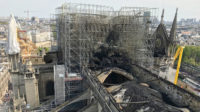Editor's note: This story was updated with new information Tuesday, April 16 at 10:15 a.m. EDT.
Monday evening in Paris, between 6:20 and 6:45 p.m. local time, a fire broke out at the Notre-Dame Cathedral, which is located in the 4th arrondissement. Flames engulfed the the 850-year-old Gothic cathedral, which was constructed in 1163 during the reign of King Louis VII and completed in 1345.
Just before 8 p.m., the structure's delicate wood-and-lead spire collapsed, followed by the portions of the roof.
It’s falling pic.twitter.com/TE705LNfdw
— Hash Miser (@H_Miser) April 15, 2019
#notredame #paris #incendie #désastre pic.twitter.com/jpNosqFGGp
— Kinsley Laurence (@KinsleyLaurence) April 15, 2019
André Finot, a spokesman for the cathedral, told the New York Times that the cause of the fire was not immediately known, and that there were no immediate signs of any injuries. The French Interior Ministry said that 400 firefighters were on the scene.
Un dispositif exceptionnel est mis en place pour éteindre l'incendie #NotreDame #Paris : 400 pompiers sont mobilisés. Évitez le secteur et suivez les consignes de @prefpolice. #HérosduQuotidien pic.twitter.com/hfKG8yFSvW
— Ministère de l'Intérieur (@Place_Beauvau) April 15, 2019
As of 10:00 p.m. local time, the French fire services told the AFP that they were "not sure" if the fire could be stopped. The deputy interior minister also said that saving Notre-Dame is "not certain."
#BREAKING French fire services say they are "not sure" if Notre-Dame fire can be stopped pic.twitter.com/Gs3Q8AZs4i
— AFP news agency (@AFP) April 15, 2019
At approximately 11 p.m., the Guardian quoted Royal Institute of British Architects President Ben Derbyshire as saying:
"The news of the tragedy this evening is of immeasurable significance worldwide. The loss of the roof and spire of Notre Dame, and possibly the stone vault too, is an irreplaceable blow to the heritage of French Gothic architecture. Our heart goes out to the people of France, and to lovers of our shared cultural heritage wherever they are."
Around the same time, a fire official in Paris told the AFP that Notre-Dame’s main structure has been “saved and preserved,” including the two towers, reports Reuters.
#BREAKING Notre-Dame's main structure is "saved and preserved" after fire, says Paris fire official pic.twitter.com/IC8fT7s593
— AFP news agency (@AFP) April 15, 2019
Speaking to the crowd gathered outside the cathedral at 11:30 p.m. local time, French President Emmanuel Macron said, "We will rebuild Notre-Dame together.”
LIVE | Déclaration depuis le parvis de #NotreDame.https://t.co/Bs2p4cpftB
— Emmanuel Macron (@EmmanuelMacron) April 15, 2019
Fifteen hours after the fire broke out, firefighters said it had been fully extinguished. On Tuesday, Laurent Nuñez, a junior interior minister, told reporters on the scene that investigators would spend the next 48 hours assessing the structure for weaknesses and vulnerabilities.
Architect Bernard Fonquernie, who oversaw work on the Notre-Dame in the 1980s and 1990s, told the New York Times that he believes furnishings and parts of the interior can be salvaged. “The stone vaulting acted like a firewall and it kept the worst heat away” from flammable fixtures like pews and a pulpit, he said, which appear in photos to be intact.
Early reports suggest that the three stained-glass rose windows appear to have been spared. And many relics, including the crown of thorns and the tunic of Saint Louis, were rescued from the fire on Monday evening and relocated to Paris City Hall, France’s culture minister Franck Riester said on French radio Tuesday morning. But Riester also indicated that the cathedral's 8,000-pipe organ, which dates back to the 1730s, “seems to be quite affected.”
The AFP reported that as of noon Tuesday, Paris time, pledged donations for reconstruction of Notre-Dame topped $680 million, including $113 million (€100 million) from fashion group Kering, founded by the French billionaire François Pinault, and $226 million (€200 million) from French billionaire Bernard Arnault and the luxury conglomerate LVMH.
The cathedral draws some 13-million visitors each year. It had been undergoing a $12-million renovation at the time of the fire.
This is a developing story. Check back later for updates.







Post a comment to this article
Report Abusive Comment